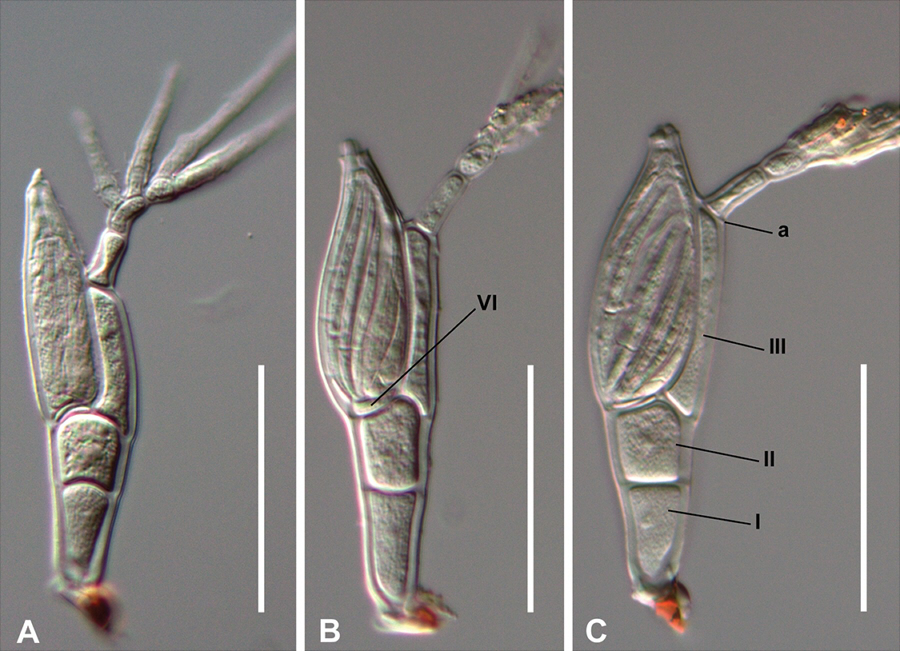LET'S LEARN ABOUT LABOULS!
I've talked about a lot of parasites on this website, but let me tell you about one of my favorite parasite groups that I've only even learned about in relatively recent years; one that might not sound all that shocking to you as we go over its life cycle and habits, but if you haven't heard of this one before, wait until I tell you just what kind of organism it really is, and see if you can guess!
Source
So the Laboulbeniales are parasites of various arthropod groups, but they're also known as "beetle hangers" after their strong preference for Coleoptera. An individual laboul is segmented and elongated, kind of like a maggot in appearance, and may have an assortment of short hairs, spines, or tentacle-like outgrowths.
A laboul spends its entire existence growing on the same host, anchored permanently in place by its "foot cell" and just barely penetrating into the host's body, drawing nutrients directly from the host's "blood" (hemolymph). At the other end of a laboul, of course, is where the babies come out. Obviously! Food goes in one end, babies out the other end! To be more specific, offspring are "fired" from this end when its "triggers" are brushed, hopefully by another viable host insect, since the new little labouls have no means of locomotion. If they aren't spat out directly onto the right food source, they'll die!

Source
One interesting thing about these lifeforms is that their body plan and lifestyle are shared by very few things other than a number of parasitic Crustaceans. An array of copepoda, in particular, spend their entire adult lives drawing nutrients from the tissues of a host fish, releasing eggs or larvae from the rest of their limbless, dangling bodies. This makes a laboul more or less the land version of what fish keepers refer to as the dreaded "anchor worms."
Labouls, however, aren't crustaceans. They aren't insects, either. Or arachnids, or leeches, or roundworms, or flatworms, or even some surprise animal group, like some REALLY messed up jellyfish. Labouls don't belong to the animal kingdom at all...so what are they!?

...THEY'RE FUNGI!

Source
Parasitism isn't unusual for fungi, no, and some parasitic fungi are famous for their flashy, dramatic "zombie" tactics, but like the vast majority of other fungi, these still consist primarily of an unseen mycelium, an amorphous network of cells arranged in thousands of thin threads that only periodically produce the fruiting bodies we sometimes call "mushrooms."

Source
A laboul, on the other hand, is contained entirely in that single, compact, maggot-shaped packet, slurping blood through the single "attachment cell" it drilled into the host exoskeleton, manufacturing large, sticky spores in the rest of its saclike "body" rather than producing "fruit." It even exhibits bilateral symmetry through its entire structure, which is almost unheard of outside the animal kingdom. It could only be more like an animal if it had a nervous system and a means of moving around on its own, but to be fair, there are genuine parasitic animals, such as Myxozoa, that have virtually lost those abilities themselves.
Labouls even forego the complex reproductive habits of so many other fungi, consisting simply of a larger "female" body that splits off into a smaller "male" body, essentially mating with its own stunted, parasitic twin brother.

Source
By the general standards of life as we know it, labouls are technically a lot less weird than other fungi, built more like what we tend to think of as a "creature" with a distinct, self-contained "body," only a couple simple sexes and even a "mouth end." But by the standards of fungi, that's so much weirder.
And while labouls don't take over and murder their hosts like a few of the more dramatic fungi running around out there, there are labouls that manipulate host behavior in a slightly different way.

Journal of Hymenoptera Research
Rickia wasmannii is a laboul that infects ants of the genus Myrmica, and in the cramped conditions of an ant colony, it's not long before almost every single worker, soldier and queen is speckled with a coat of living vampiric fluff.
If you know anything about ants, however, you may know that they tend to be a bit xenophobic. Even ants of the same species are prone to kill an unfamiliar worker ant on sight, or rather on "smell," since ants rely primarily on chemical signature to identify one another.
No parasite wants their house to get ripped apart by another house, so Ricky actually alters the chemical profile of its host ants in such a way that they're significantly less likely to be identified as "enemies" by rival colonies, what parasite of the day compares to turning hosts into "faceless mannequins." Hosts, too, become noticeably less aggressive than they were before infection, the fungus essentially "keeping them out of trouble."

Source
What's also interesting about this particular laboul is that it can even be found infecting creatures that live among its host ants, like this mite, which would imply that it isn't necessarily adapted to the ants on a biological level, but adapted to the conditions of their colonies. It's only their "identity wiping" that's finely tuned to Myrmica biochemistry, extending its own life by turning these normally violent, territorial hosts into non-threatening pacifists.
Labouls are fungi that effectively evolved into blood-sucking cannons, and in stark contrast to every known zombie apocalypse, some of them nefariously reduce the amount of time their hosts spend trying to bite each other.